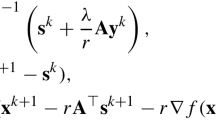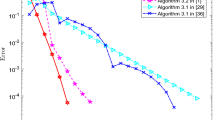Abstract
This paper first proposes another proof of the necessary and sufficient conditions of solution uniqueness in 1-norm minimization given recently by H. Zhang, W. Yin, and L. Cheng. The analysis avoids the need of the surjectivity assumption made by these authors and should be mainly appealing by its short length (it can therefore be proposed to students exercising in convex optimization). In the second part of the paper, the previous existence and uniqueness characterization is extended to the recovery problem where the L1 norm is substituted by a polyhedral gauge. In addition to present interest for a number of practical problems, this extension clarifies the geometrical aspect of the previous uniqueness characterization. Numerical techniques are proposed to compute a solution to the polyhedral gauge recovery problem in polynomial time and to check its possible uniqueness by a simple linear algebra test.
Similar content being viewed by others
References
Zhang, H., Yin, W., Cheng, L.: Necessary and sufficient conditions of solution uniqueness in 1-norm minimization. J. Optim. Theory Appl. 164(1), 109–122 (2015). doi:10.1007/s10957-014-0581-z
Chen, S., Donoho, D., Saunders, M.: Atomic decomposition by basis pursuit. SIAM J. Sci. Comput. 20, 33–61 (1998). doi:10.1137/S1064827596304010
Natarajan, B.: Sparse approximate solutions to linear systems. SIAM J. Comput. 24(2), 227–234 (2005). doi:10.1137/S0097539792240406
Candès, E., Tao, T.: Decoding by linear programming. IEEE Trans. Inf. Theory 51(11), 4203–4215 (2005). doi:10.1109/TIT.2005.858979
Donoho, D.: Compressed sensing. IEEE Trans. Inf. Theory 52(4), 1289–1306 (2006). doi:10.1109/TIT.2006.871582
Blanchard, J., Cartis, C., Tanner, J.: Compressed sensing: how sharp is the restricted isometry property? SIAM Rev. 53(1), 105–125 (2011). doi:10.1137/090748160
Eldar, Y., Kutyniok, G. (eds.): Compressed Sensing: Theory and Applications. Cambridge University Press, Cambridge (2012)
Harchaoui, Z., Juditsky, A., Nemirovski, A.: Conditional gradient algorithms for norm-regularized smooth convex optimization. Mathematical Programming (2014). doi:10.1007/s10107-014-0778-9
Juditsky, A., Kılınç Karzan, F., Nemirovski, A.: Verifiable conditions of \(\ell _1\)-recovery for sparse signals with sign restrictions. Math. Program. 127(1), 89–122 (2011). doi:10.1007/s10107-010-0418-y
Juditsky, A., Nemirovski, A.: Accuracy guarantees for \(\ell _1\)-recovery. IEEE Trans. Inf. Theory 57(12), 7818–7839 (2011). doi:10.1109/TIT.2011.2162569
Juditsky, A., Nemirovski, A.: On verifiable sufficient conditions for sparse signal recovery via \(\ell _1\) minimization. Math. Program. 127(1), 57–88 (2011). doi:10.1007/s10107-010-0417-z
d’Aspremont, A., El Ghaoui, L.: Testing the nullspace property using semidefinite programming. Math. Program. 127(1), 123–144 (2011). doi:10.1007/s10107-010-0416-0
Nesterov, Y., Nemirovski, A.: On first-order algorithms for l1/nuclear norm minimization. Acta Numerica 2013(22), 509–575 (2013). doi:10.1017/S096249291300007X
Donoho, D., Huo, X.: Uncertainty principles and ideal atomic decomposition. IEEE Trans. Inf. Theory 47(7), 2845–2862 (2001). doi:10.1109/18.959265
Zhang, Y.: A simple proof for recoverability of \(\ell _1\)-minimization: go over or under? Technical Report TR05-09, Department of Computational and Applied Mathematics, Rice University, P.O. Box: Houston. Texas 77251(2005), (1892)
Candès, E., Tao, T.: Near-optimal signal recovery from random projections: universal encoding strategies? IEEE Trans. Inf. Theory 52(12), 5406–5425 (2006). doi:10.1109/TIT.2006.885507
Cohen, A., Dahmen, W., DeVore, R.: Compressed sensing and best k-term approximation. J. Am. Math. Soc. 22(1), 211–231 (2009). doi:10.1090/S0894-0347-08-00610-3
Chandrasekaran, V., Recht, B., Parrilo, P., Willsky, A.: The convex geometry of linear inverse problems. Found. Comput. Math. 12(6), 805–849 (2012). doi:10.1007/s10208-012-9135-7
Candès, E., Recht, B.: Simple bounds for recovering low-complexity models. Math. Program. 141(1–2), 577–589 (2013). doi:10.1007/s10107-012-0540-0
Fuchs, J.: On sparse representations in arbitrary redundant bases. IEEE Trans. Inf. Theory 50(6), 1341–1344 (2004). doi:10.1109/TIT.2004.828141
Dossal, C.: A necessary and sufficient condition for exact sparse recovery by \(\ell _1\) minimization. C. R. Acad. Sci. Paris 350(1–2), 117–120 (2012). doi:10.1016/j.crma.2011.12.014
Grasmair, M., Haltmeier, M., Scherzer, O.: Necessary and sufficient conditions for linear convergence of \(\ell _1\)-regularization. Commun. Pure Appl. Math. 64(2), 161–182 (2011). doi:10.1002/cpa.20350
Candès, E., Romberg, J., Tao, T.: Robust uncertainty principles: exact signal reconstruction from highly incomplete frequency information. IEEE Trans. Inf. Theory 52(2), 489–509 (2006). doi:10.1109/TIT.2005.862083
Rockafellar, R.: Convex Analysis. No. 28 in Princeton Mathematics Ser. Princeton University Press, Princeton (1970)
Hiriart-Urruty, J.B., Lemaréchal, C.: Convex Analysis and Minimization Algorithms. No. 305–306 in Grundlehren der mathematischen Wissenschaften. Springer, Berlin (1993)
Borwein, J., Lewis, A.: Convex Analysis and Nonlinear Optimization—Theory and Examples. No. 3 in CMS Books in Mathematics. Springer, New York (2000)
Polyak, B.: Sharp minima (1979). Presented at the IIASA Workshop on Generalized Lagrangians and Their Applications, IIASA, Laxenburg, Austria (1979)
Polyak, B.: Introduction to Optimization. Optimization Software, New York (1987)
Burke, J., Ferris, M.: Weak sharp minima in mathematical programming. SIAM J. Control Optim. 31, 1340–1359 (1993). doi:10.1137/0331063
Bertsekas, D.: Nonlinear Programming, 2nd edn. Athena Scientific, Belmont (1999)
Bonnans, J., Gilbert, J., Lemaréchal, C., Sagastizábal, C.: Numerical Optimization—Theoretical and Practical Aspects, Universitext, 2nd edn. Springer, Berlin (2006)
Friedlander, M., Macêdo, I., Pong, T.: Gauge optimization and duality. SIAM J. Optim. 24(4), 1999–2022 (2014). doi:10.1137/130940785
Chvátal, V.: Linear Programming. W.H. Freeman, New York (1983)
Goldman, A., Tucker, A.: Theory of linear programming. In: Kuhn, H., Tucker, A. (eds.) Linear Inequalities and Related Systems, no. 38 in Annals of Mathematics Studies, pp. 53–97. Princeton University Press, Princeton (1956)
Balinski, M., Tucker, A.: Duality theory of linear programs, a constructive approach with applications. SIAM Rev. 11, 347–377 (1969). doi:10.1137/1011060
Saigal, R.: Linear Programming—A Modern Integrated Analysis. Kluwer Academic Publisher, Boston (1995)
Roos, C., Terlaky, T., Vial, J.P.: Theory and Algorithms for Linear Optimization—An Interior Point Approach. Wiley, Chichester (1997)
Wright, S.: Primal-Dual Interior-Point Methods. SIAM Publication, Philadelphia (1997)
Armand, P., Gilbert, J., Jan-Jégou, S.: A feasible BFGS interior point algorithm for solving strongly convex minimization problems. SIAM J. Optim. 11, 199–222 (2000). doi:10.1137/S1052623498344720
Gilbert, J., Gonzaga, C., Karas, E.: Examples of ill-behaved central paths in convex optimization. Math. Program. 103, 63–94 (2005). doi:10.1007/s10107-003-0460-0
Moreau, J.J.: Proximité et dualité dans un espace hilbertien. Bulletin de la Société Mathématique de France 93, 273–299 (1965). http://www.numdam.org/item?id=BSMF_1965__93__273_0
Zhao, Y.B., Luo, Z.Q.: Constructing new weighted \(\ell _1\)-algorithms for the sparsest points of polyhedral sets. Tech. rep. (2016). http://www.optimization-online.org/DB_FILE/2016/08/5570.pdf
Author information
Authors and Affiliations
Corresponding author
Rights and permissions
About this article
Cite this article
Gilbert, J.C. On the Solution Uniqueness Characterization in the L1 Norm and Polyhedral Gauge Recovery. J Optim Theory Appl 172, 70–101 (2017). https://doi.org/10.1007/s10957-016-1004-0
Received:
Accepted:
Published:
Issue Date:
DOI: https://doi.org/10.1007/s10957-016-1004-0
Keywords
- Basis pursuit
- Convex polyhedral function
- Gauge recovery
- L1 minimization
- Minkowski function
- Optimality conditions
- Sharp minimum
- Solution existence and uniqueness




